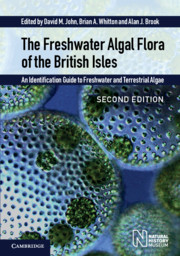 The Freshwater Algal Flora of the British Isles
The Freshwater Algal Flora of the British Isles Book contents
- Frontmatter
- Contents
- The online material (formerly provided in DVD format)
- List of Contributors
- Foreword
- Preface
- Acknowledgements
- Introduction
- Distribution and Ecology
- History of Freshwater Algal Studies in the British Isles
- Field Methods
- Laboratory Methods
- Water Framework Directive
- Cultures of British Freshwater Algae
- Classification
- Key to phyla
- Cyanobacteria (Cyanophyta)
- Phylum Rhodophyta (Red Algae)
- Phylum Euglenophyta (Euglenoids)
- Phylum Cryptophyta (Cryptomonads)
- Phylum Dinophyta (Dinoflagellates)
- Phylum Raphidophyta
- Phylum Haptophyta (Prymnesiophyta)
- Phylum Chrysophyta (Golden Algae)
- Phylum Xanthophyta (Tribophyta) (Yellow-Green Algae)
- Phylum Eustigmatophyta
- Phylum Bacillariophyta (Diatoms)
- Phylum Phaeophyta (Brown Algae)
- Primitive Green Algae (‘PRASINOPHYTA’)
- Phylum Chlorophyta (Green Algae)
- Phylum Glaucophyta
- Glossary
- Standard Form of Authors of Algal Names
- Sources of Illustrations or Material
- References
- Taxonomic Index
- Subject Index
- Plate Saction
- Miscellaneous Endmatter
- Miscellaneous Endmatter
Phylum Euglenophyta (Euglenoids)
Published online by Cambridge University Press: 12 January 2024
- Frontmatter
- Contents
- The online material (formerly provided in DVD format)
- List of Contributors
- Foreword
- Preface
- Acknowledgements
- Introduction
- Distribution and Ecology
- History of Freshwater Algal Studies in the British Isles
- Field Methods
- Laboratory Methods
- Water Framework Directive
- Cultures of British Freshwater Algae
- Classification
- Key to phyla
- Cyanobacteria (Cyanophyta)
- Phylum Rhodophyta (Red Algae)
- Phylum Euglenophyta (Euglenoids)
- Phylum Cryptophyta (Cryptomonads)
- Phylum Dinophyta (Dinoflagellates)
- Phylum Raphidophyta
- Phylum Haptophyta (Prymnesiophyta)
- Phylum Chrysophyta (Golden Algae)
- Phylum Xanthophyta (Tribophyta) (Yellow-Green Algae)
- Phylum Eustigmatophyta
- Phylum Bacillariophyta (Diatoms)
- Phylum Phaeophyta (Brown Algae)
- Primitive Green Algae (‘PRASINOPHYTA’)
- Phylum Chlorophyta (Green Algae)
- Phylum Glaucophyta
- Glossary
- Standard Form of Authors of Algal Names
- Sources of Illustrations or Material
- References
- Taxonomic Index
- Subject Index
- Plate Saction
- Miscellaneous Endmatter
- Miscellaneous Endmatter
Summary
The euglenophytes or euglenoids contain about 54 freeliving genera. Most are colourless with heterotrophic nutrition, which is sometimes entirely osmotrophic, but in others also phagotrophic. However, about onethird of the genera are green and phototrophic and the majority of well known taxa in freshwater bodies are in fact green.
Currently about 900 species are known, of which just over 250 are colourless. These are usually placed in the phylum Euglenophyta by botanists, who recognize a single class having two (Bourrelly, 1985), three (Asaul, 1975) or six (Leedale, 1967) orders. Zoologists place the euglenophytes in the Protozoa and divide the Order Euglenida into five suborders (Lee et al., 1985; Leedale and Vickerman, 2000). Ultrastructural surveys of cell structure and subsequent molecular investigations have revealed a close relationship to two groups of flagellate protozoa, the trypanosomatids and diplonemids (Graham et al., 2009).
The euglenophytes are a diverse group of largely solitary and motile flagellates, although a few species form non-motile, branched colonies when in the actively growing condition and, more rarely, they are epiphytes (e.g. Colacium). The cells are typically obovoid, clavate, spindle or lance-shaped, cylindrical, and most are naked, with the plasma membrane surrounded by an often prominent pellicle with helical striations. Some forms are radially symmetrical (Gyropaigne kosmos), others are bilaterally symmetrical. The pellicle ranges from very flexible to semi- or completely rigid, and is usually striated. The striations are frequently twisted with respect to the longitudinal axis. There are muciferous bodies under the pellicle, which eject mucilage that forms layers around the cell.
The genera Trachelomonas, Strombomonas and Ascoglena are surrounded by an extracellular matrix, termed a lorica, which is often impregnated by deposits of ferric and/or manganic compounds (Leedale, 1975; Dunlap et al., 1983). At the anterior end a narrow canal leads into a flask-shaped reservoir, the anterior invagination. Adjacent to the enlarged basal portion are one or more active contractile vacuoles. In certain genera, there may be a rod-shaped organelle parallel to the reservoir. The canal is a continuation of the cytoplasmic membrane. At higher magnification, microtubules are often seen to be in association with the canal. The contractile vacuole may be almost spherical before discharge into the reservoir, and is frequently reported as being surrounded by several ‘subsidiary’ vacuoles.
The flagella are inserted in the latero-posterior wall of the reservoir.
- Type
- Chapter
- Information
- The Freshwater Algal Flora of the British IslesAn Identification Guide to Freshwater and Terrestrial Algae, pp. 181 - 239Publisher: Cambridge University PressPrint publication year: 2021
Accessibility information
- 3
- Cited by
